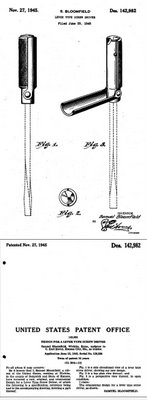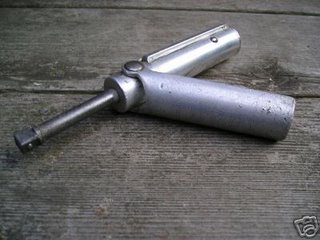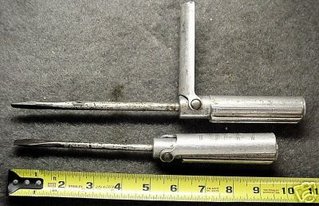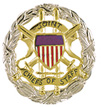Swallow Airplane Co. and the
The Tuffy Screwdriver
( somewhat disorganized, constantly being fiddled as new stuff turns up)
This is a cleverly-designed tool with a fascinating history. I inherited one from my father in 1957; he flew small planes (Pipers & Cessnas) after WW2 and Korea but I don't know where he picked up this screwdriver. I picked up my next one about 1973 from an Army helicopter pilot, who told me that he got it from an Army chopper mechanic. The mechanic had told him that the Army used to order these for the tool kits, but they were stolen at such a rapid rate that the Army stopped buying them -- or so he was told. Frankly, I now doubt this. The Army has a real penchant for stamping or marking things like tools (I spent 21 years on active duty) -- I’ve never seen a Tuffy so marked, and I’ve got maybe thirty or more. Also, considering the time I spent around Army choppers, fixed-wing aircraft, and vehicles , I never saw a Tuffy in any of them. It's possible that the Army bought some Tuffys at some point -- perhaps a local purchase by a motor pool -- but certainly not mass purchases.
For the next 20-some years it was my favorite screwdriver because it was absolutely indestructible no matter how much it was abused. Mine was used as a prybar, as a chisel and to hammer nails. Of course its real strong point was when you had an old rusty screw that wouldn't come out -- you could put all your weight on the handle and then turn the folding "wing" for incredible leverage. For years I wondered why no one made these any more, and all my friends tried to steal mine. Finally back in 1997 I thought to look it up on eBay's search and I turned up a few. My interest increased when I discovered Swallow's connection to Piper and Beech, since I learned to fly as an eight-year-old in my father's Piper Cub and, later, his Cessna (a 140, I think).
Eventually I picked up dozens of Tuffys, but all my searching on the Internet old tool and antique tool websites brought no info at all on these tools, and very little on the maker. None of the old tool experts had ever heard of it, or were very interested. If it’s not an old woodworking hand tool, or a major name like SnapOn or Craftsman, old tools are just …old tools, and have no collector interest, and little value. If these were marked SnapOn or even Craftsman from the 40s, , they’d be fifty bucks a pop instead of averaging six to eight bucks, or less, on eBay. I’ve picked up several for a two-dollar opening bid.
Eventually an eBay seller, an old aircraft buff who lives in Wichita where aviation “grew up,” gave me some of the history, and I’ve picked up bits & pieces on the Web, from other eBay buyers & sellers, and from aircraft historians. This is still kind of raw data, collected piecemeal, and I try to point out which parts are fairly certain and which are possibly flaky:
Laird Aircraft, between 1920 (maybe earlier) and 1923-24, built a biplane called the Swallow. When Laird left the company (probably in 1923) they renamed the company Swallow Aircraft and, later, the Swallow Airplane Company (Sometimes called Swallow Airplane Manufacturing Co.). By 1924 Jake Moellendick ran the company, and in that year two senior Swallow employees – Lloyd Stearman and Walter Beech – left the company to join with Clyde Cessna and form the Travelair company; all three eventually built planes under their own names, also. The less-than-friendly split centered on Moellendick’s refusal to use tubular metal frames rather than the “traditional” wood frame. Swallow built fabric-covered biplanes, some more “modern” monoplanes, and even some very impressive racing planes from about ’24 (?) to ’35, providing many of the original planes for the government air mail contracts. Charles Lindbergh flew one as a young airmail pilot before he became famous through his solo transatlantic flight (I have a photo of him sitting in his Swallow). Production numbers for Swallow planes are a bit fuzzy, but it looks like there were 45 Swallows built by Laird, and after the Swallow model became a separate company in ’24 (?), there were about 1350 planes built until production stopped in ’35. Some sources say that Swallow became separate in ’27 rather than ’24, but the consensus seems to be the earlier date.
In one advertisement, the Swallow sold “for only $1,795” which apparently included some flying instructions.
The question of when the company (Swallow) actually began is very tricky, and sources disagree considerably. Some of the confusion is due to company name changes, from Laird to Swallow Airplane to Swallow Aircraft, etc. At this point I don’t have a clear answer. One Wichita history source claims that Swallow Airplane Co. started as early as 1919, but I suspect they’re confusing Laird’s company and HIS Swallow with the follow-on company run by Moellendick.
I have often heard that there are still a number of these old biplanes around, most carefully restored, valuable classic biplanes and that most of the owners have a full set of the Tuffy screwdrivers “that came in the Swallow'’s tool kit.” However, after reviewing some old Wichita newspaper articles (kindly provided to me by Walter Beech’s grand-nephew, Walter Burns) and finding the original Tuffy patent (dated 1945), that is clearly just another colorful fairy tale.
In a 1970 article the Wichita papers mention that the last known Swallow aircraft in flying condition had just paid a visit to Wichita, and before it was restored it had sat in pieces for 43 years. They also mention that there were only two other known Swallows, both in museums. (update: The Cleveland Air Show website does indicate, however, that in their 1976 air show there was a restored, flying 1925 Swallow in attendance, which would suggest that it was a “Swallow Airplane Company” Swallow rather than a Laird Swallow -- the semantics can get tricky).
There is at least one Swallow Airplane Co. Swallow still flying, owned by the EAA AirVenture Museum in Oshkosh, Wisconsin. Since it’s still taking up paying passengers, it’s claimed to be the oldest commercial aircraft still in service. It’s a 1927 Swallow OX-5, and there is a lot of interesting information on this aircraft, and the various Swallows, at
http://www.airventuremuseum.org/collection/aircraft/Swallow%20OX-5.asp#TopOfPage
For those doing Internet searches, I should mention that the German firm Messerschmitt also made a popular model called the Swallow, which can really raise Hell with your searches ….
Originally I thought there were three sizes of Tuffy, but now I see that there seem to be four sizes (12 3/4", 10 3/4", 9 3/4" and 9 1/8") and almost all are regular straight blade. I do have two original Phillips-head which are far less common. The TUFFY brand was apparently Swallow Airplane’s “house brand” for the tools they manufactured, apparently long after they stopped making airplanes.
Some sources mention Clyde Cessna as an early employee, but his biographies state that he owned a Swallow at one point but they only mention his partnering with Beech and Stearman after they left Swallow.
Added: from avn history website --- “1923: E M Laird Aviation Co Inc, Wichita KS. 1923: Swallow Airplane Mfg Co (Jacob M "Jake" Moellendick, Charles L Laird, Walter Beech, Lloyd Stearman, others), 29 St and Hillside,, reorganized from Laird partnership. 1927: Swallow Airplane Co. 1927: Receivership, but with some refinancing in 1933 (E B Christopher), remained operational until 1956 as an aircraft mechanic school and subcontractor for B-29 and B-47 components.”
Apparently during the Great Depression Swallow Air, like all other plane builders, fell on hard times and began to branch out, manufacturing parts and tools for other manufacturers, and marketing some of their tools, such as the Tuffys. In 1941 Swallow Air had 116 employees training students in aircraft design and manufacturing, probably due to wartime needs, and were probably still producing parts and tools because of the war. After World War II the demand for plane parts and tools, and training, simply dried up.
After that, the history gets extremely fuzzy. Swallow Airplane Co. was gone, though, even as a parts-and-tools supplier, by 1956. In 1999, just before I discovered the history of Swallow Air, I ran across a surplus catalog that listed a large (13") model of the Tuffy, but in Phillips-head, which was a new one on me at the time. The picture in the catalog was obviously a Tuffy and they were only a few dollars each. I immediately ordered two, and when I got them they were definitely the same Tuffys I was used to, but absolutely brand new and shiny. The inside was marked,"TUFFY TOOL CORP. QUINTER KANSAS," with a Zip Code, which of course dated them no earlier than the 1960's. I talked to a few people in Quinter (which is quite small), and no one knew anything except for one guy who only knew that at some point someone had gotten ahold of the tooling for the old Tuffy screwdrivers and set up making them in Quinter. The operation folded very quickly, but no one seemed to know any details. I called to order more of the screwdrivers from the surplus catalog, but they had sold out and couldn't (or wouldn't) tell me anything about the source of the screwdrivers. One guy I talked to in Quinter mentioned that he also had something he described as a "neat little nut-driver/quarter-inch socket set" made by Tuffy in Quinter. Every time I see my shiny new Phillips-head Tuffy, I kick myself for not ordering a dozen or so for two bucks apiece, even though they aren’t, strictly speaking, “original” Tuffys.
One Tuffy fan, who, like me, has quite a few of them, tells me that back in the early 50s Tuffys were sometimes distributed through some hardware stores and by traveling salesmen (probably similar to the distribution of SnapOn or MAC tools today), who went around to commercial tool users – in one case he knew of, to a rural blacksmith shop. They were available thru mail-order, though I don't know where this was advertised. Each new Tuffy did come with a little brochure with a tear-off coupon to order more of them.
I haven’t yet determined how long Tuffys were made, or exactly when they started, and the only hard data I have so far is:
-- The Tuffy’s patent was applied for 25 June 1945, with Sam Bloomfield listed as the inventor, and approved 27 Nov 1945. I have a scan with the patent drawing and the Patent # 142, 982. Though I have owned dozens of Tuffys and seen hundreds of others, I have never seen one with a patent number, only “Patents Pending” (note the plural). Many of the very new “clones” make no reference to patent at all.
-- in Feb 1946 Swallow was producing 100,000 Tuffys per month.
This would seem to indicate that Tuffys were not produced until a decade after their last aircraft rolled off the line in ’35. So much for my earlier thoughts that perhaps Charles Lindbergh had used one of my Tuffys on his airmail plane.
I did find a Wichita newspaper article that mentions the Tuffy production and states that they were designed by Sam Bloomfield, who was General Manager of Swallow (and one of the country’s premier rare coin collectors) at that time. He endowed a chair at an engineering school, which has his papers, but a search through them yielded no information on Tuffys. Since they are nearly indestructible, most are still around, usually gathering dust in Grandpa’s old rusty toolbox in someone’s barn or garage, with their history long forgotten. Most of them are at least 50 years old and are still very usable, historic tools with a strong historic connection to the early days of flight.
Since this history is rapidly disappearing, and so few who own Tuffys know their origin, I try to find good homes for many of the ones I find, preferably with young mechanics with an appreciation for fine tools, and I pass on this little history with the tool, which is why I originally wrote it.
Some rather interesting Tuffy items appeared on eBay in the Spring of 2004: several nearly-mint Tuffys with their original box and papers, an original Phillips-head Tuffy (which I obtained) and a Tuffy socket-driver --- the first one I had ever seen, and another appeared in the summer of ’06. Neither nut-driver attracted much bidding; I didn't even bid myself. This socket or nutdriver is basically a regular Tuffy screwdriver with a 3/8” (I believe) drive head. Not exactly what I had heard about earlier, and it was just the driver without any sockets, but it does confirm that there were some socket-driving variations of the tool, and causes one to suspect that out there somewhere are some Tuffy-branded sockets.
In perhaps the most interesting development so far, about June ‘06 I picked up on eBay (for just a few bucks) a completely unique … Tuffy, though ‘pre-Tuffy’ or 'proto-Tuffy' might be more accurate. It is a nine-inch straight-blade model, round shank, but WITHOUT the torque wing. The handle is a simple octagonal billet of the usual aircraft aluminum, and it’s stamped SWALLOW AIRPLANE CO. INC WICHITA KANSAS –USA – (no Tuffy indication at all). The handle has a relieved thumb-groove near the shank. It’s the only one I’ve ever seen or heard of. I haven't posted a photo of it here yet, but will get around to it eventually.
Another wrinkle: In Sep 06 an eBay seller advertised “new” Tuffys, and the photos looked about right. I ordered one regular, one Phillips. I believe they were about eight bucks apiece. The seller states that his supplier is using the original tooling for these new screwdrivers. They seem to be reasonably well-made though I have had little opportunity to use them. The Phillips-head apparently missed a step in manufacturing since it has no hemispherical recess in the “wing” for the spring-loaded ball detent to “catch” when it closes. Though the ouside of the wing says TUFFY and Made in USA, the inside of the wing is blank, so there is no reference to Swallow at all on the tool.
Any further information on Tuffys, or corrections to this half-baked history, would be very much appreciated.
Revised Sep 2007
-----------------------------------------------------------------------------------------------------------------
ADDENDUM, July 2003:
There are some new TUFFY “clones” of as yet unknown quality and origin, in Phillips & Flathead, marked inside as “KP Enterprises INC Denver Colorado” or “Salem Tool & Mfg Co, Daleville Indiana” They have a faint gold-colored coating over the normal aluminum, and the script of “TUFFY” on the wing is somewhat slanted instead of vertical, as on the originals. The flat blades are shaped differently, also – octagonal shank. I have located Salem Tool, but they don’t answer their phone, and the Denver company doesn’t seem to exist anymore either. (As of Sep ’07 , I still don’t know a thing about these “new” Tuffys)
(added: These Tuffy “clones,” for lack of a better term, seem to be of decent quality, probably equal to any modern hardware-store-level tool like Stanley or Craftsman. I can’t tell if the steel shanks are up to the old indestructible Tuffy standards, but the handles seem to be a very tough alloy, much like the old ones, and appear to be made from the same tooling. If you’ve handled a lot of Tuffys the shank and tip differences are obvious, but the slanted letters of “TUFFY” and the odd yellowish color are easy to spot for anyone. I’ve used these new ones for a while, and while they’re not “real” Tuffys as most of us think of them, they’re decent tools, though perhaps closer in quality to the “Sears”-marked screwdrivers than the better “Craftsman” brand. The quality control is spotty: one of mine has the spring-loaded ball detent in the handle ... but no corresponding recess in the "wing" for it to lock into!)
Saturday, January 13, 2007
Subscribe to:
Posts (Atom)












